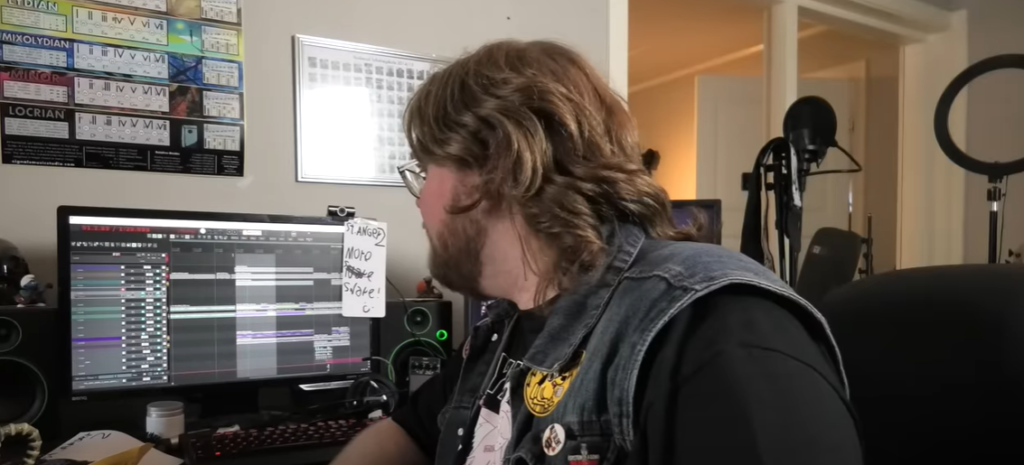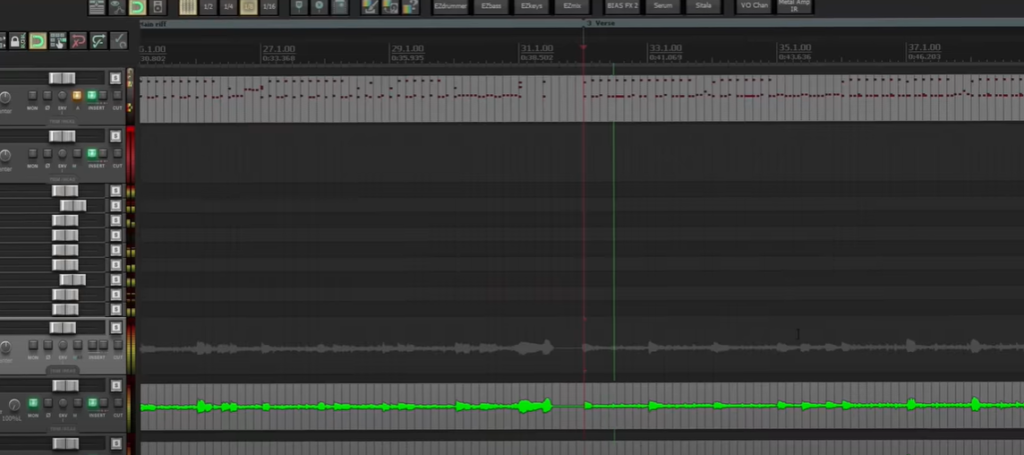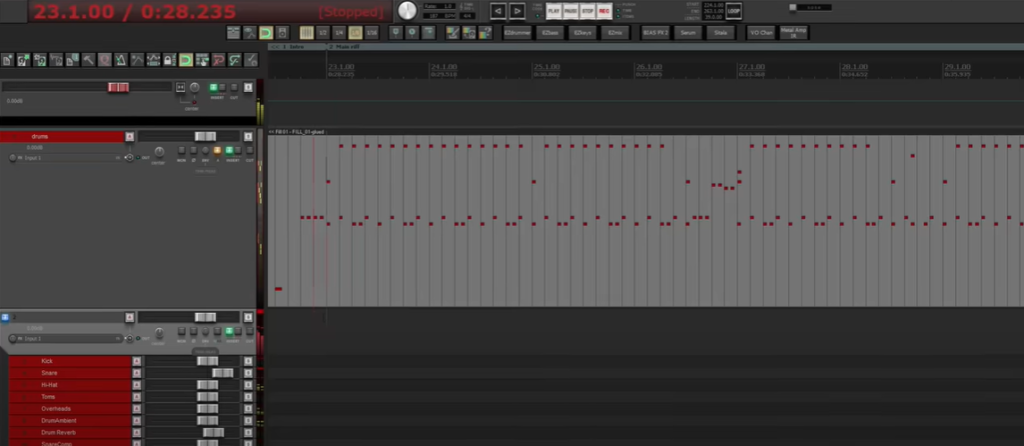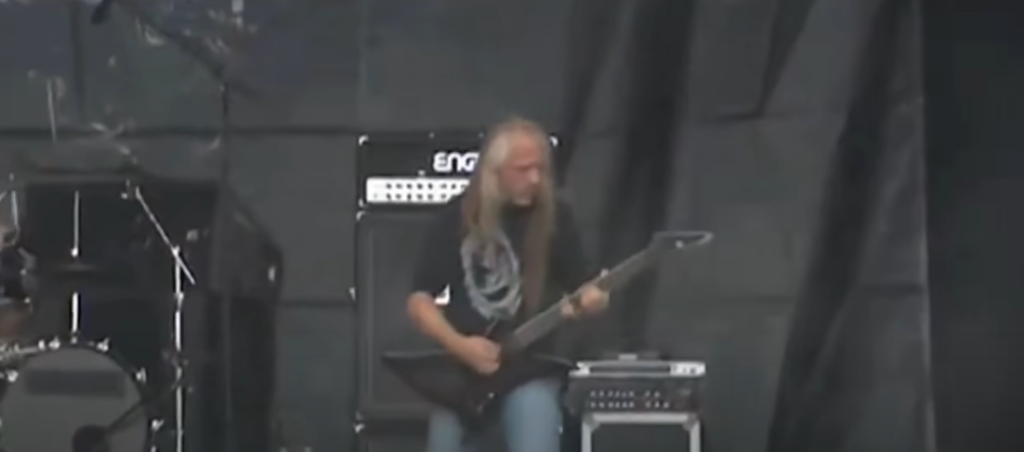A good vocalist can be the heart and soul of a band, often being the main focal point for audiences. In thrash metal, vocalists are known for their intense energy and powerful performances. But how does one become a successful thrash metal vocalist? It takes more than just screaming into a microphone, and in this guide we will explore the key elements to mastering this unique style of singing.
Table of Contents
What is Thrash Metal?
Before we embark on our exploration of the captivating realm of thrash metal vocals, let’s take a moment to delve into the essence of this exhilarating genre. Thrash metal, a subgenre of heavy metal that emerged in the early 1980s, swiftly captured the hearts of music enthusiasts throughout the decade and beyond. Known for its lightning-fast tempo and ferocious guitar riffs, this genre exudes an unrelenting energy that is further intensified by its incorporation of elements from punk and hardcore music. Brace yourself for an exhilarating journey into the captivating world of thrash metal vocals![2]

The Role of the Thrash Metal Vocalist
In thrash metal, the vocalist plays a vital and commanding role in driving the intensity and raw energy of a live performance. Their presence on stage is electrifying as they deliver powerful and thought-provoking lyrics that often tackle social and political injustices head-on. With their voice as both an instrument and a means of communication, they captivate the audience and ignite a fire within.
The vocalist’s ability to convey emotion, aggression, and conviction through their voice adds another layer of intensity to the already explosive nature of thrash metal. Their performance becomes a cathartic release, resonating with fans who connect deeply with the message behind the music. It is this combination of musical prowess, lyrical depth, and sheer passion that sets thrash metal vocalists apart and solidifies their pivotal role in the genre.[2]
Different Vocal Styles in Thrash Metal
Within thrash metal, there are various vocal styles that have evolved over time. Some of the most iconic and influential vocalists in this genre hail from bands like Metallica, Slayer, and Anthrax, to name a few. Let’s take a closer look at some of the distinct vocal techniques used by these legendary artists.
- James Hetfield, the legendary frontman of Metallica, is internationally recognized for his aggressive and dynamic vocal delivery. His unique style combines a blend of fierce growls and electrifying high-pitched screams, creating a captivating and powerful sound that defines the band’s signature sound.
- Tom Araya, the iconic vocalist of Slayer, is celebrated for his intense and ferocious vocals. His deep growling style adds an eerie and haunting element to Slayer’s music, contributing to their reputation as one of the pioneers of thrash metal.
- Joey Belladonna, the exceptional singer of Anthrax, brings a more melodic approach to his vocals. With a versatile range, he skillfully combines clean singing techniques with powerful shouts and screams, adding depth and intensity to Anthrax’s music. Belladonna’s dynamic vocal abilities showcase his undeniable talent and contribute to the band’s unique sound.[2]
Each vocalist brings their unique style to the table, adding to the diversity and richness of thrash metal vocals. And while there are commonalities among these styles, each artist has a distinct sound that sets them apart and contributes to the genre’s dynamic appeal.

Mastering Thrash Metal Vocal Techniques
Scream, Shriek, or Growl: Finding Your Style
To become a successful thrash metal vocalist, one must have a solid understanding of the various vocal techniques used in this genre. From high-pitched screams that pierce through the chaotic guitar riffs to deep growls that resonate with raw intensity, and powerful shouts that ignite the energy of the crowd, each technique requires precise training and execution to achieve the desired effect.
The first step is to experiment with different vocal styles and find what works best for you. Dive into the gritty world of metal vocals, exploring the nuances of guttural roars, demonic shrieks, and spine-chilling wails. With relentless practice and unwavering determination, you can sculpt your own unique sound that sets you apart from other vocalists, crafting a sonic identity that leaves a lasting impact on the thrash metal scene. Embrace the power of your voice and unleash it in a symphony of aggression and passion that resonates with the souls of metalheads worldwide.[1]
Techniques for Achieving Powerful Vocal Delivery
While each vocalist may have their own unique style, there are several fundamental techniques that every thrash metal singer must master in order to deliver a powerful and dynamic performance. These techniques go beyond just raw talent and include proper breath control, vocal warm-ups, and throat relaxation exercises.
When it comes to thrash metal vocals, breathing is key. Learning how to control your breath and use it effectively can make all the difference in maintaining vocal stamina on stage. This involves understanding the different breathing techniques, such as diaphragmatic breathing, and practicing them to develop the necessary control and power in your vocals.

In addition to breath control, vocal warm-ups play a crucial role in preparing your voice for the rigors of performing. These warm-ups not only help to loosen up your vocal cords but also ensure that your voice is ready to give it your all every time you step on stage. They typically include exercises that target different areas of your vocal range and help to improve flexibility, tone, and overall vocal quality.
By mastering these fundamental techniques and incorporating them into your vocal routine, you can enhance your thrash metal singing skills and deliver performances that are both powerful and captivating. So, remember to prioritize your vocal health and invest time in practicing these techniques to take your vocal abilities to the next level.[1]
Tips for Consistency and Endurance on Stage
Performing as a thrash metal vocalist requires not only technical skill but also physical and mental endurance. The energy and intensity of this genre demand a lot from its performers, making consistency and endurance crucial for delivering an unforgettable live performance.
To maintain vocal consistency on stage, it is important to stay hydrated and avoid consuming dairy or caffeine before a show. These substances can cause excess mucus and throat dryness, which can negatively impact your vocal performance. It is also important to warm up your voice before each show and incorporate proper breathing techniques to conserve energy and prevent vocal strain.
In terms of endurance, it is crucial to take care of your overall health. Getting enough rest, eating well-balanced meals, and exercising regularly are all essential for vocal stamina. Additionally, working with a vocal coach can help you develop proper breathing and performance techniques that will allow you to sustain your energy and deliver consistent performances night after night.[1]
Iconic Thrash Metal Vocalists and Their Techniques
In the world of thrash metal, there are countless iconic vocalists who have left an indelible mark on the genre. Let’s take a closer look at some of these legendary artists and their unique vocal techniques.
- James Hetfield from Metallica is known for his aggressive and powerful shouting style that perfectly complements the band’s heavy riffs. He uses a combination of chest and head voice to achieve this unique sound.
- Tom Araya from Slayer is known for his aggressive growls and guttural screams, which he achieves by using his diaphragm and throat muscles to create a deep, intense tone.
- Chuck Billy from Testament showcases a wide range of vocal techniques in his performances, from high-pitched screams to guttural growls and everything in between. His incredible control and use of different vocal styles make him a standout vocalist in the thrash metal scene.
- Angela Gossow from Arch Enemy is known for her powerful and guttural growls, achieved through proper breath control and diaphragmatic support. She also incorporates melodic singing into her performances, making her a versatile and dynamic vocalist.[2]
These are just a few examples of the diverse vocal techniques and styles used by thrash metal vocalists. By studying and learning from these iconic artists, you can continue to develop and refine your own unique sound as a thrash metal vocalist.
![]()
Maintaining Vocal Health
Avoiding Vocal Strain and Injury
As a thrash metal vocalist, your vocal health should be a top priority. The intense and aggressive nature of this genre can put a lot of strain on your voice, making it crucial to take care of yourself both on and off stage.
To avoid vocal strain and injury, it is important to use proper technique when performing. This includes controlling your breath, avoiding excessive screaming or shouting, and taking breaks when necessary. It is also important to stay hydrated and avoid irritants such as alcohol and smoking.
If you do experience vocal strain or injury, it is important to rest your voice and seek help from a vocal coach or medical professional if needed. Ignoring potential issues could lead to more severe problems in the future, so it is always better to take care of your vocal health proactively.[3]
Vocal Health Maintenance Tips
Aside from using proper technique and taking care of your voice on stage, there are also steps you can take to maintain overall vocal health. Some tips include:
- Staying properly hydrated by drinking plenty of water throughout the day helps keep your vocal cords lubricated and prevents dryness.
- When your voice is tired or strained, it is advisable to avoid excessive talking or whispering, as this can further strain your vocal cords and hinder their recovery.
- Regularly resting your voice, especially after intense performances or prolonged periods of speaking, allows your vocal cords to recuperate and reduces the risk of vocal fatigue.
- Consuming a well-balanced diet that includes a variety of fruits and vegetables provides your body with essential nutrients, which can contribute to overall vocal health.
- It is also advisable to avoid irritants such as alcohol, smoking, and excessive caffeine consumption, as these substances can dry out your vocal cords and potentially lead to vocal damage.[3]
By incorporating these tips into your daily routine, you can maintain vocal health and prevent potential issues from arising.
Recovery and Rehabilitation for Injured Voices
Even with proper care and precautions, vocal injuries can still occur due to various factors such as overuse, improper technique, or sudden strain. If you do experience an injury or strain, it is crucial to prioritize rest and take necessary measures to ensure a prompt recovery. Seeking professional help from a voice specialist, such as a speech therapist or vocal coach, can provide valuable guidance and tailored exercises to aid in the rehabilitation process.
These experts can assist in identifying the specific muscles or areas affected by the injury and guide you through targeted exercises and techniques to strengthen and heal them. By following their guidance, you can regain vocal strength and flexibility while minimizing the risk of further damage.
Additionally, it is essential to listen to your body and be patient with the recovery process. Rushing back into intense vocal performances prematurely can exacerbate the injury and prolong the healing time. Give yourself ample time for rest and gradually reintroduce vocal activities, starting with less demanding tasks before gradually increasing the intensity.
Remember, taking proper care of your vocal health and seeking professional assistance when needed are vital steps in ensuring long-term vocal well-being and maintaining optimal performance capabilities.[3]

FAQ
How do you get heavy metal vocals?
There is no one-size-fits-all answer to achieving heavy metal vocals, as each vocalist has their own unique style and technique. However, some tips for developing a strong and powerful vocal performance in the thrash metal genre include practicing proper breathing techniques, utilizing both chest and head voice, and incorporating different vocal styles and ranges.
How to practice metal singing?
To practice metal singing, it is important to warm up properly before each session. This can include vocal exercises such as lip trills, tongue stretches, and scales. It is also crucial to take breaks when needed and avoid straining your voice. Additionally, listening to and studying vocalists in the genre can provide valuable insights and techniques for improvement.
How to do harsh vocals?
Harsh vocals, also known as screams or growls, require proper technique and breath control to avoid strain and injury. It is important to use your diaphragm and throat muscles rather than just forcing sound from your vocal cords. Working with a vocal coach can provide guidance on specific techniques and exercises for achieving harsh vocals safely.
How do metal singers growl?
Metal singers use different techniques to achieve growls, but some common approaches include using vocal fry, creating throat tension, and manipulating the position of the tongue and lips. These techniques can take practice and should be done in a controlled manner to avoid damaging your voice. Again, working with a professional can provide valuable guidance for achieving growls safely.
How do metal scream?
Screaming in metal vocals requires proper breath control and support to avoid strain and injury. It is important to use your diaphragm and throat muscles rather than just forcing sound from your vocal cords. Different techniques such as false cord or fry screaming can also be utilized, but it is essential to learn these techniques from a trained professional to prevent damage to the vocal cords.
Is metal screaming easy?
While it may seem effortless when done correctly, metal screaming requires proper technique and control to avoid strain and injury. It is important to take the time to learn proper techniques and warm-ups, as well as give your voice breaks when needed. With practice and guidance from a vocal coach, you can develop strong and sustainable metal vocals without compromising your vocal health.
Is metal screaming hard?
As with any vocal style, metal screaming can be challenging to master and requires proper technique and control. It is crucial to approach it with caution and seek professional guidance to avoid damaging your voice. With dedication, practice, and proper care, you can achieve powerful and versatile metal vocals while prioritizing your vocal health. Thus, it is important to have passion for the genre and a strong desire to continually improve and maintain your vocal health.
Useful Video: How To Be A Thrash Metal Vocalist w/TONY FORESTA
Conclusion
In conclusion, being a thrash metal vocalist requires more than just raw talent and passion for the genre. It also demands proper vocal care, technique, and dedication to continuously improve and maintain optimal vocal health. By incorporating tips for maintaining overall vocal health, seeking professional assistance when needed, and practicing with caution and patience, you can achieve strong and sustainable metal vocals while prioritizing your vocal well-being. Remember, take care of your voice, and it will take care of you on stage. So keep practicing, stay hydrated, warm up properly, and never hesitate to seek professional help when needed. Keep rocking and have a blast as a thrash metal vocalist!
References:
- https://www.learnabout-art.com/how-to-sing-thrash-metal/
- https://ourpastimes.com/how-to-do-thrash-metal-vocals-12553609.html
- https://www.wikihow.com/Do-Harsh-Death-Metal-Vocals






Leave a Reply